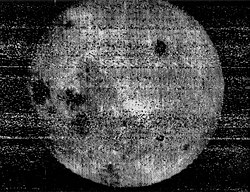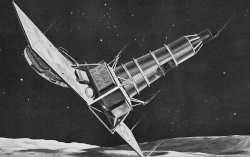Moon landing
A Moon landing is the arrival of a spacecraft on the surface of the Moon. It is a follow up to Project Mercury. This includes both crewed and uncrewed (robotic) missions. The first man-made object to reach the surface of the Moon was the Soviet Union's Luna 2 mission, on 13 September 1959.[1]
The United States' Apollo 11 was the first crewed mission to land on the Moon, on 20 July 1969.[2] There have been six missions with people onboard that landed on the Moon between 1969 and 1972. There were also numerous landings without people onboard, with no soft landings happening from 22 August 1976 until 14 December 2013.
To date, the United States is the only country to have successfully landed humans on the Moon. The last mission was in December, 1972, and the last human to walk on the Moon was Gene Cernan.
Moon Landing Media
Still frame from a video transmission, taken moments before Neil Armstrong became the first human to step onto the surface of the Moon, at 02:56 UTC on 21 July 1969. An estimated 500 million people worldwide watched this event, the largest television audience for a live broadcast at that time.
Stamp with a drawing of the first soft landed probe Luna 9, next to the first view of the lunar surface photographed by the probe
The view through the window of the Lunar Module Orion shortly after Apollo 16's landing
A 1963 conceptual model of the Apollo Lunar Excursion Module
Lunar ascent by Apollo 17 ascent stage.
Neil Armstrong and Buzz Aldrin land the first Apollo Lunar Module on the Moon, 20 July 1969, creating Tranquility Base. Apollo 11 was the first of six Apollo program lunar landings.
References
- ↑ "Luna 2". NASA–NSSDC.
- ↑ NASA Apollo 11 40th anniversary.










